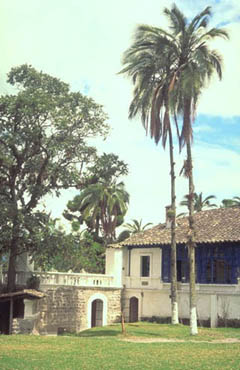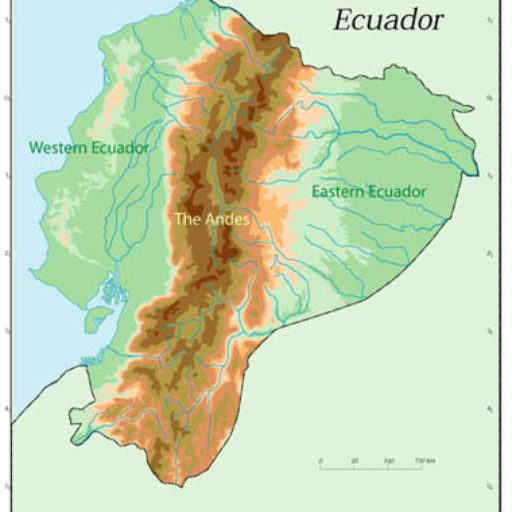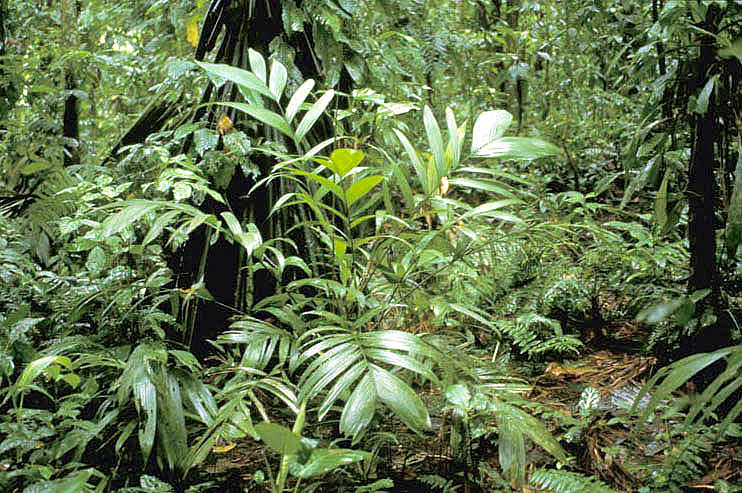Solitary palmtree ca. 7 m tall; trunk heavily armed with spines of various sizes up to 18 cm long, oriented in different direction, larger spines mainly pointing downwards and semiterete in cross section; leafscars conspicuous to the ground, lower 219 cm or 15 nodes of trunk without spines; total number of nodes 51; trunk 390 cm from base to lowermost leaf, diam. at DBH 19 cm, diam. below lowermost leaf 17.5 cm; internodal length basally to 12 cm, apically app. 4 cm. One juvenile spear shaped leaf; leaves 12; transition between petiolar and sheathing region gradual the two together being 170 cm long; leafsheath split to the base, encircling 1/3-2/3 of trunk circumference; sheathing and petiolar region heavily armed with brown spines that are black apically and of various length to 12.5 cm, pointing straight out and upward; petiolar region convex-concave in cross section, whitish dewed green, with median ridge above and without spines abaxially, 4 cm wide below lowermost pinna; rachis 281 cm long, above green to yellowish green, below greyish dewed, ad- and abaxially armed with spines of various length, the abaxial ones being biggest to 6 cm, pointing straight out and upward, rachis proximally flattened above, narrowing gradually into a sharp ridge being conspicuous at 130 cm from the base; pinnae inserted in groups of (from base): 1+3+2+1+2+3+2+1+3+1+5+5+5+2+5+1+4+3+3+2+2+3+3+4+2+1+4+3+1+2+1+1+2+1+1+1+2+1+1+1+1+(a several times plicated apical pinna); pinnae lustrous dark green and with prominent yellowish midnerve above, whitish below, pointing in different directions: distal pinnae of each group held at -5¡ and proximal pinnae at 45¡ relative to transversal plane. Infructescence: interfoliar; peduncle 157 cm long, oval in cross section, 3 cm wide at insertion of 1st sheathing bract to 5 cm wide below lowermost rachillae, whitish dewed green, heavily armed with flattened spines of various length to 6 cm, that are brown with black tips and pointing straight up out and upward; rachis 84 cm long, whitish dewed green, lowermost 8 cm armed with flattened brown spines to 1.5 cm long and pointing straight out, rachillae 200, irregular distributed, single or in groups of up to 4, each rachillae or group of rachillae subtended by a single brown, thinly chartaceous, deltoid bract, central rachillae biggest to 14 cm long and 0.6 cm wide, cross section oval. Numboer of fruits per rachillae 5, the proximal ones only ca. 3 cm from the base; calyx persistent three-lobed, basally adnate, lobes ovate, 0.8 x 1 cm, green with minute adpressed spines, marginally brown; petals persistent to 1.3 cm long, basally adnate, splitting irregularly, orange with minute adpressed spines, marginally brown; fruit ovoid with pointed apex, 5 x 3.5 cm, orange verrucose down to 8th node from base. Common name: “Mocora”. Use: Fruit with edible mesocarp, red, fleshy and delicious tasting when eaten crude. Best compared to the fruits of Spodias purpurea (“Ovo”) but with less fibers. Fruits sold on markets in Esmeraldas for up to 1 s./each. The palmtrees are said to bear fruits all year long. The fruits are also highly esteemed by birds. The palmito is eaten and said to be delicious, however the extraction demands a lot of work. Finally the yellow pinnae of juvenile leaves are dried and used for making baskets and hats. A “Mocora” hat is worth from 200 to 1000s./. Dupl. QCA, MECN.
Latest posts by admin (see all)
- Aluminium Rattan Garden Furniture Design Ideas - September 11, 2019
- Popular Gardens and Parks in Sheffield, United Kingdom - September 18, 2018
- How New Eco-Friendly Garden Benches Help Plants and Consumers in the UK - February 26, 2018




Discussion: